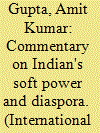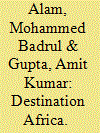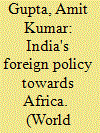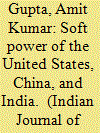| Srl | Item |
| 1 |
ID:
084704


|
|
|
| 2 |
ID:
058231


|
|
|
|
|
| Publication |
New Delhi, Tulika, 2001.
|
| Description |
viii, 283p.Hbk
|
| Standard Number |
8185229414
|
|
|
|
|
|
|
|
|
|
|
|
Copies: C:1/I:0,R:0,Q:0
Circulation
| Accession# | Call# | Current Location | Status | Policy | Location |
| 044514 | 954.03/GUP 044514 | Main | On Shelf | General | |
|
|
|
|
| 3 |
ID:
108567


|
|
|
| 4 |
ID:
133572


|
|
|
|
|
| Publication |
2014.
|
| Summary/Abstract |
India has been using benign means to develop its relations with Africa based on consultations and cooperation, mediated by an increasingly active diplomacy. Mohammed Badrul Alam and Amit Kumar Gupta aver that in contrast to China's strategy, India has focussed on capacity building rather than infrastructure development.
|
|
|
|
|
|
|
|
|
|
|
|
|
|
|
|
| 5 |
ID:
176431


|
|
|
| 6 |
ID:
131593


|
|
|
|
|
| Publication |
2013.
|
| Summary/Abstract |
As countries compete for dominance in International Politics, soft power has emerged as a major tool for nation states to ensure enhancement of their intangible standing, besides strengthening their in?uence in a benign way. The United States, China and India are considered prime examples in the ?eld of soft power, though the nature, intent, and fruition of soft power vary in each case. This article attempts to highlight and analyze the diverse nature of soft power that these countries possess, and illuminate as to how di?etently they have used their soft power resources. And ?nally an attempt has been made to put forward a case that each of these countries presents itself as an archetype-- they may learn from each other's successes and missteps in the domain of soft power.
|
|
|
|
|
|
|
|
|
|
|
|
|
|
|
|